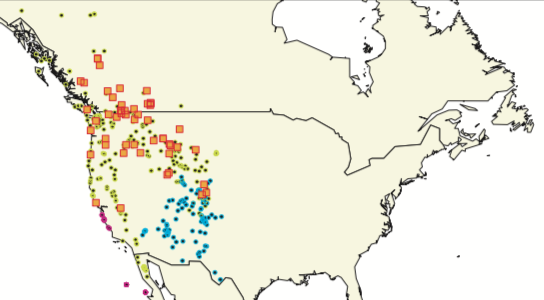• MSc or PhD scholarship offer: Integrative aphid taxonomy
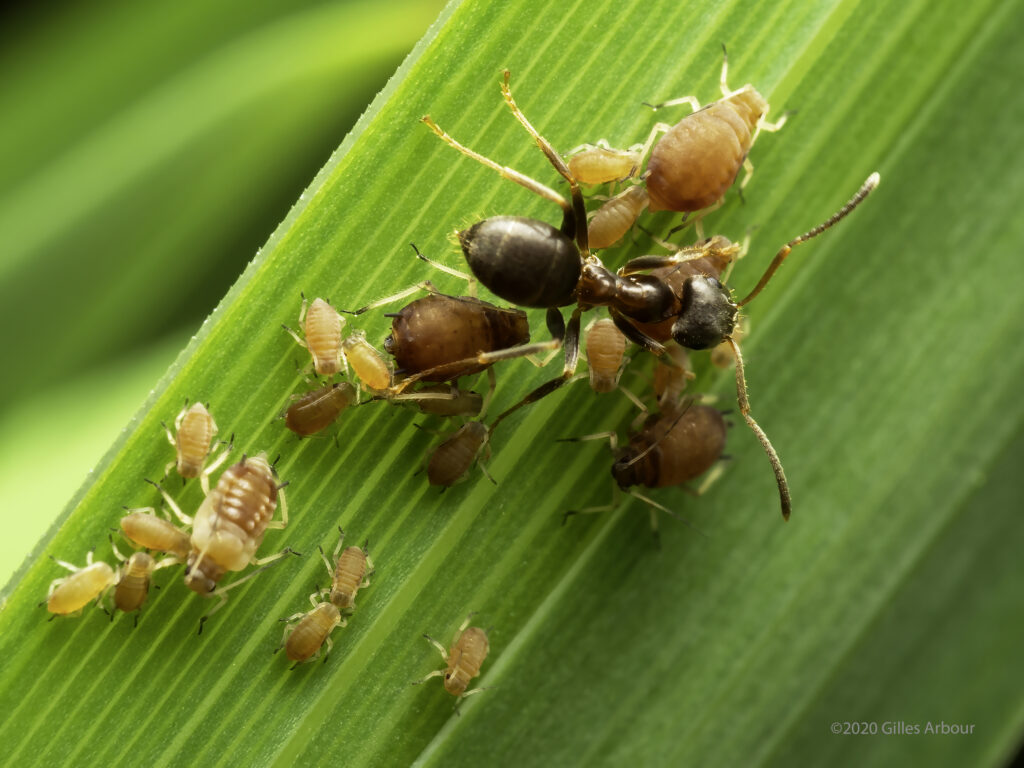
PROJECT SUMMARY
The student will conduct an integrative cybertaxonomic revision of a genus of arboreal aphid using biological data such as DNA sequences, morphology, and host plant association. The project is comprehensive, addressing the discovery, delimitation, diagnosis and description of species or subgenera, as well as the preparation of specimen determination tools. It involves fieldwork, molecular and microscopic lab work, computer analyses and digital data networking.
Although the project focuses on aphids, the goal is to train an entomologist capable of adapting their knowledge and skills to other taxa.
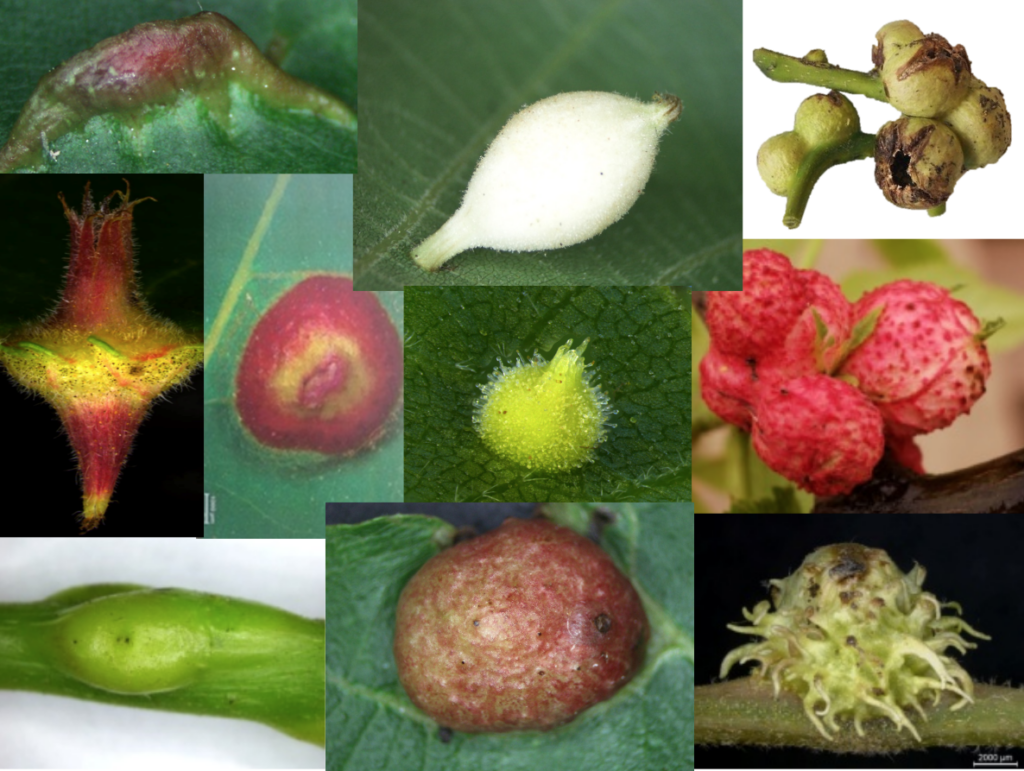
REQUIRED PROFILE
The candidate holds a university degree at the bachelor’s (for MSc) or master’s (for PhD) level, in biology or a related field. He or she has a strong interest in entomology and systematics and meets the eligibility requirements of the Department of Biological Sciences at the University of Montreal. Note that the University of Montreal is a French-language institution and that although proficiency in French is not a requirement for the studentship, it will be an important consideration.
DETAILS
Remuneration: scholarship of $18,000 (MSc) or $20,000/year (PhD); may be supplemented by teaching assistantships and other sources of funding.
Duration: 2 years (MSc) or 4 years (PhD)
Location: Plant Biology Research Institute (IRBV), located on the grounds of the Montreal Botanical Garden
Start date: May or September 2025
Supervision: Colin Favret

TO APPLY
Send to Colin Favret (colin.favret@umontreal.ca) (1) your curriculum vitæ, (2) a one-page cover letter, (3) your transcript(s), and (4) the names and contact information of two people who can serve as references. The position remains open until the best candidate is found.
• MSc scholarship offer: weevil temporal diversity in Panama
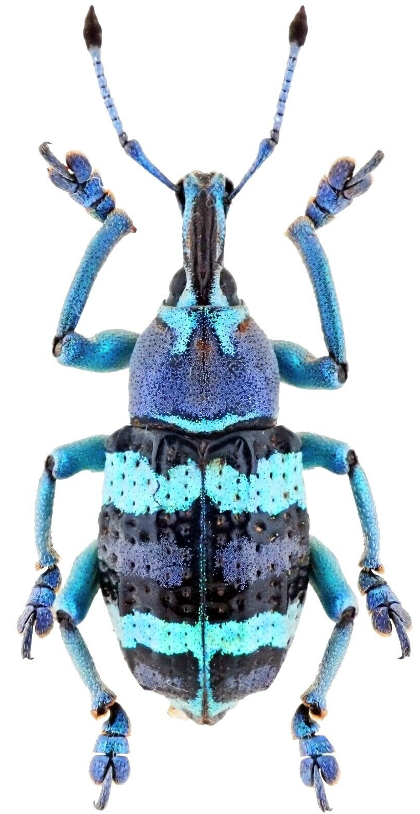
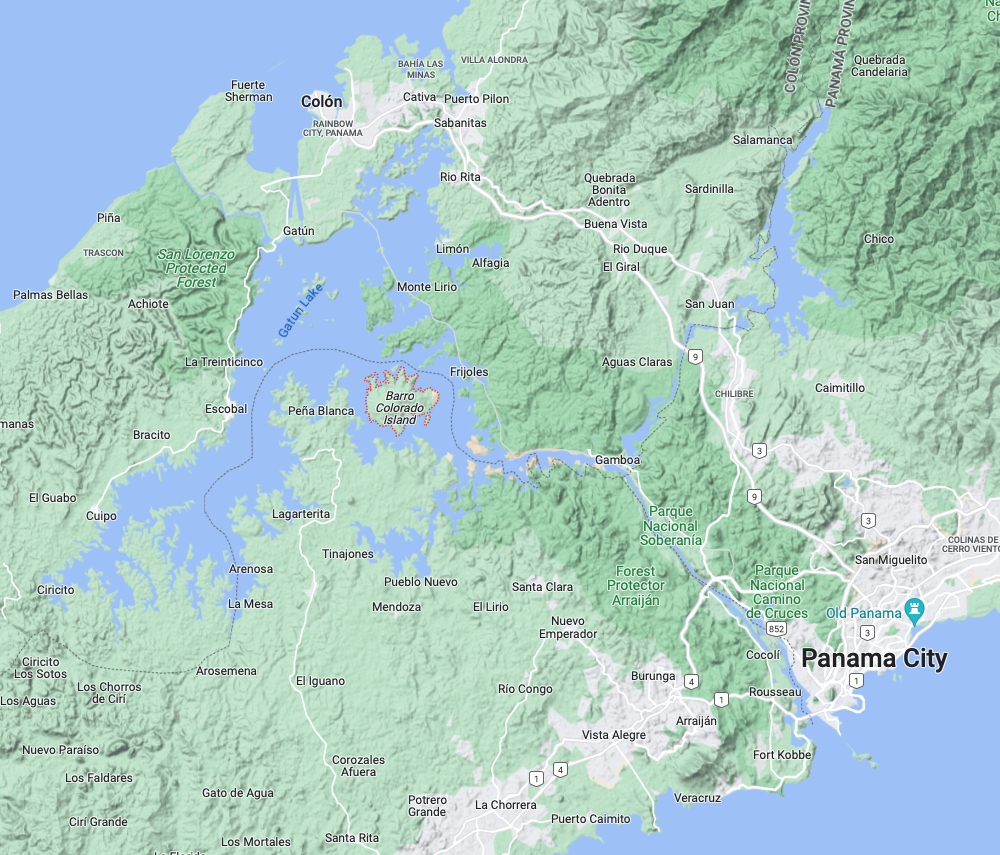
Project description
• From 1999 to 2017, at the Smithsonian Tropical Research Institute’s Barro Colorado Island Biodiversity Research Center in Panama, adjacent to a tropical forest plot established in 1982 for the study of forest evolution, ten Malaise traps systematically captured around 15,000 weevil specimens (family Curculionidae) representing 1,350 species. Specimens were identified by a weevil specialist.
• This computational project will analyze temporal changes in weevil diversity in relation to environmental (mainly climatic) and vegetation changes. The sheer volume of data from the three datasets (insects, plants, meteorology) makes this a project of the highest scientific calibre.
• The person recruited will be supervised by entomologist Colin Favret and numerical ecologist Pierre Legendre, with the participation of tropical beetle specialist Hector Barrios Velazco.
Eligibility requirements
• Interest in computational analysis of biodiversity data and experience in entomology
• University degree (B.Sc. or equivalent)
• Good oral and written communication skills
We encourage women, LGBTQ+, aboriginal, individuals of all backgrounds, or with a disability, to apply.
Benefits
• $15,000/year scholarship for 2 years
• Additional financial support available (teaching assistantships, scholarships)
• Flexible working conditions (flexible hours, remote work)
• Wonderful work environment: entomology lab on the grounds of the Montreal Botanical Garden; supportive team of friendly colleagues
Dates
• Evaluation of applications will begin in November 2023, but applications will be considered until the right candidate is recruited.
• The study program will last two years, starting in the 2024 winter or summer term.
How to apply
• Please send (1) a cover letter, (2) your CV, (3) your transcript (photocopy acceptable), and (4) the names and contact details of two references, to: Colin Favret, colin.favret@umontreal.ca.
• Article: The effects on insects of plant-associated microorganisms
We are delighted that the last two chapters of Élisée’s thesis have just been jointly published in the journal Microorganisms. He only just completed his PhD! They discuss the effects of beneficial microorganisms associated with soybean roots on the health of insect populations of the second and third trophic levels (an herbivore and its natural enemies).
Beneficial microorganisms such as arbuscular mycorrhizal fungi and rhizobium bacteria are known to modify plant performance traits through the supply of important nutrients, especially phosphorus and nitrogen. Previous studies looked at these interactions yielding variable results depending on the context. We examined at the cascading effects that beneficial organisms can cause on insects of the second and third trophic levels. We first wanted to confirm, in a controlled environment, the influence on the soybean aphid (Aphis glycines, second trophic level) of the tripartite symbiosis between an arbuscular mycorrhizal fungus (Rhizophagus irregularis), a bacterium (Bradyrhizobium japonicum), and the soybean plant (Glycine max) (First article). This study showed a significant increase in aphid colony growth in the presence of the double inoculant, mycorrhiza plus rhizobium and, albeit less so, in the presence of the rhizobium inoculant alone. This effect on the aphid is certainly a consequence of changes in plant chemistry induced by the microorganisms. The study shows that two symbionts can improve the performance of plants and phytophagous insects beyond what each symbiont can provide alone.
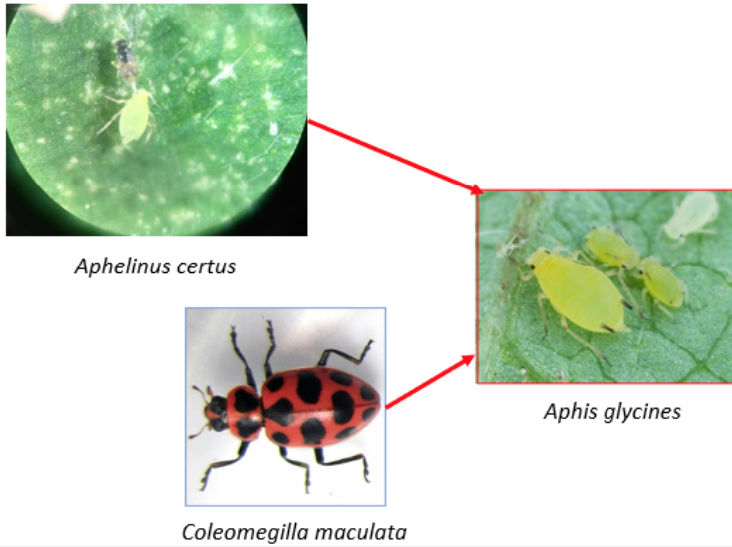
Secondly, we were interested in the effects of these same inoculants on the natural enemies of the soybean aphid, the predatory lady beetle (Coleomegilla maculata) and the parasitoid (Aphelinus certus) (Second article). The only significant result was with the parasitoid that showed a significant decrease in the rate of emergence from the pupal stage in the presence of the rhizobium inoculant. No difference was observed for any other fitness variable measured in either natural enemy.
In the light of the results of these consecutive studies, it appears that the confirmed advantages that microbe-plant symbioses confer upon the second trophic level are little transferred to the third.
- Dabré ÉE, Hijri M, Favret C. 2022. Influence on soybean aphid by the tripartite interaction between soybean, a rhizobium bacterium, and an arbuscular mycorrhizal fungus. Microorganisms, 10(6): 1196. DOI: 10.3390/microorganisms10061196
- Dabré ÉE, Brodeur J, Hijri M, Favret C. 2022. The effects of an arbuscular mycorrhizal fungus and rhizobium symbioses on soybean aphid mostly fail to propagate to the third trophic level. Microorganisms, 10(6): 1158. DOI: 10.3390/microorganisms10061158
• Recruiting: Master’s student in insect pathology
We’re recruiting a motivated student interested in studying insect pathology and insect production for consumption at the University of Montreal starting in September 2022!
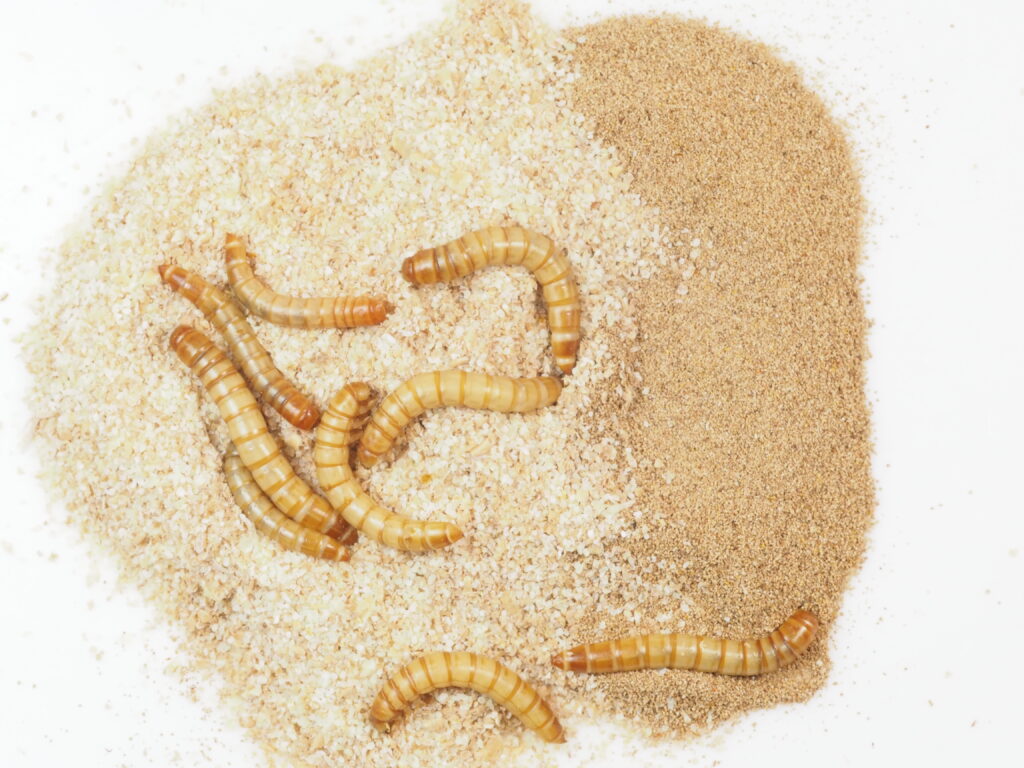
SUMMARY OF THE PROJET. Global demand for animal protein is expected to double by 2050. Following an FAO (2013) publication praising the ecological and nutritional merits of edible insects, as compared to conventional meats, mealworm farming is expanding rapidly. However, insect farms are grappling with rearing problems related to pathogens. Despite the urgency to act, too little is known regarding insect pathogen outbreaks, on preventative methods, and on increasing mealworm immunity. This project aims to characterize different mealworm strains and evaluate rearing methods to improve their resistance to bacterial and fungal pathogens.
CANDIDATE PROFILE. The successful candidate will have a bachelor’s degree in a field of biology and an interest in entomology. The person must also meet the eligibility conditions of the Department of Biological Sciences of the Université de Montréal. French proficiency is not a pre-requisite.
PAY. Scholarship worth $15000/year (supplementable)
DURATION: 2 years, starting September 2022, or as soon as the student arrives
LOCATION: Institut de recherche en biologie végétale, on the grounds of the Montreal botanic garden
SUPERVISION: Colin Favret and Étienne Normandin
HOW TO APPLY. Send your curriculum vitæ, a one-page cover letter, and your university grade transcript to Étienne Normandin (etienne.normandin-leclerc@umontreal.ca). The position will remain open until filled.
• Newly minted: Dr Dabré
Many congratulations to the new PhD! Élisée successfully defended his dissertation 28 March 2022 and has since submitted the final version to the university: The effects of arbuscular mycorrhizal fungal and rhizobacterial inoculants on soybean insects. Soil microorganism inoculants are often used in agriculture to boost the growth and hence the yield of various crops, including soybean. However, it is not clear how these inoculants might affect pest insects feeding on the plants. Perhaps the inoculants, by stimulating plant growth, contribute to providing a larger, healthier meal to herbivorous insects, increasing negative pest effects. Alternatively, if the inoculants increase the health and vigor of the plants, perhaps they help the plants defend themselves against herbivorous insects. Finally, if the herbivorous insects are affected by the presence of soil inoculants, whether positively or negatively, might those effects be transmitted to the next trophic level, that is, to the predators and parasites of the herbivorous insects?
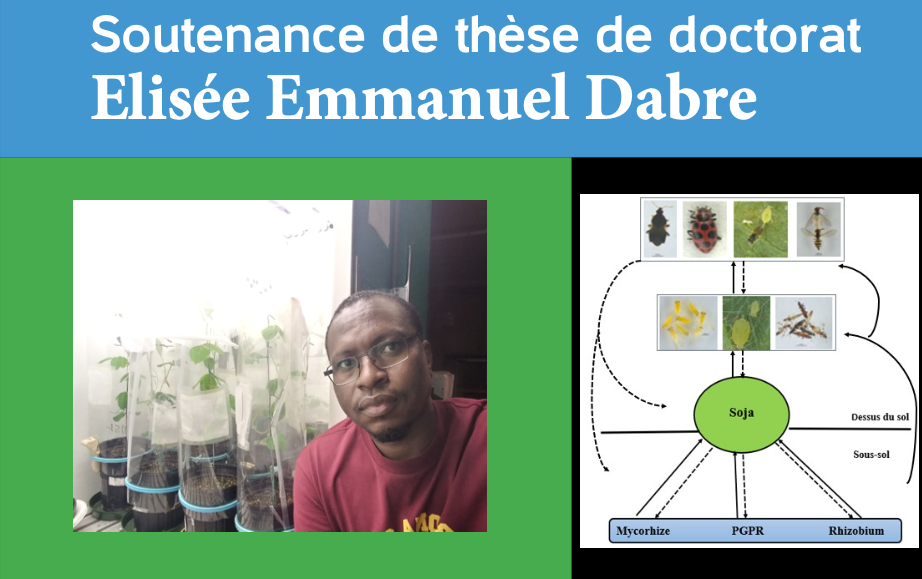
Élisée’s dissertation is composed of three scientific chapters, each examining these issues at different organizational levels: the first and second trophic levels (aphids on soybean); the third trophic level (a predator and a parasitoid of the soybean aphid); the insect community in an agricultural field.
In his first manuscript, he found that, in a laboratory setting, the presence of arbuscular mycorrhizal fungal and rhizobacterial inoculants enhanced both the growth of soybean itself and the population growth of the soybean aphid. There was a synergistic effect where the two inoculants stimulated plant and aphid population growth more than either inoculant alone.
In his second manuscript, Élisée took the same model system and measured the development time and other health parameters of a ladybird beetle predator and a parasitoid wasp feeding on aphids reared on plants growing in inoculated soil. In this experiment, he found that whatever effects inoculation had on soybean aphids were not generally transferred to the next trophic level.
Finally, in his third manuscript, published in PLOS ONE, Élisée looked at the effects on the insect community of the field-inoculation of arbuscular mycorrhizal fungi and rhizobacteria, as well as the effects on the insect community of different levels of mycorrhizal colonization of soybean roots. Just as inoculation stimulated aphid colony growth in his first experiment, Élisée found a greater abundance of piercing-sucking insects (notably the soybean aphid and leafhoppers) in inoculant-treated parcels. However, and contrary to that finding, he found a negative correlation between the rate of mycorrhizal colonization and the abundance and diversity of piercing-sucking and chewing herbivorous insects. This is a very complicated study system: as well as the inoculated microorganisms, the ‘natural’ agricultural environment also has a native flora whose abundance and diversity Élisée was not able to measure.

• Dabré ÉE, Lee Soon-Jae, Hijri M, Favret C. 2021. The effects of mycorrhizal colonization on phytophagous insects and their natural enemies in soybean fields. PLOS ONE 16(9): e0257712. DOI: 10.1371/journal.pone.0257712
• Shining stars at the Quebec entomology society meeting
With four oral presentations and two posters, the lab was well-represented at the virtual annual meeting of the Quebec entomology society this year (25 November 2021).
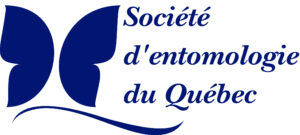
Élisée Emmanuel Dabré (PhD student) presented the results of his experiments, examining the effects of bacterial and fungal root inoculation on the soybean aphid and its natural enemies.
Malek Kalboussi (MSc student) presented on her progress developing low-cost high-throughput insect DNA barcoding methods, particularly in the choice of DNA extraction protocols and mini barcode primers.
Mehdi Ouazzani Touhami (MSc intern) presented the results from his study of scuttle fly diversity at the Laurentian Biology Research Station.
Gaspard Tanguay-Labrosse (BSc student) presented the circadian rhythm of the ensemble of parasitoid wasp diversity in a forested landscape.
Amélie Quésnel‘s (BSc student) poster described some of that parasitoid diversity studied by Gaspard and the interactive identification key she has developed. The key, not destined for publication, is critical for our research so that lab members can classify future samples into the same groups.
Catherine Hébert‘s (BSc student) poster presented the results of 48-hour bioblitz that took place in an urban park this past summer. Her study focussed on bee diversity in particular. For her fine work, Catherine was awarded the best student poster award: bravo Catherine!
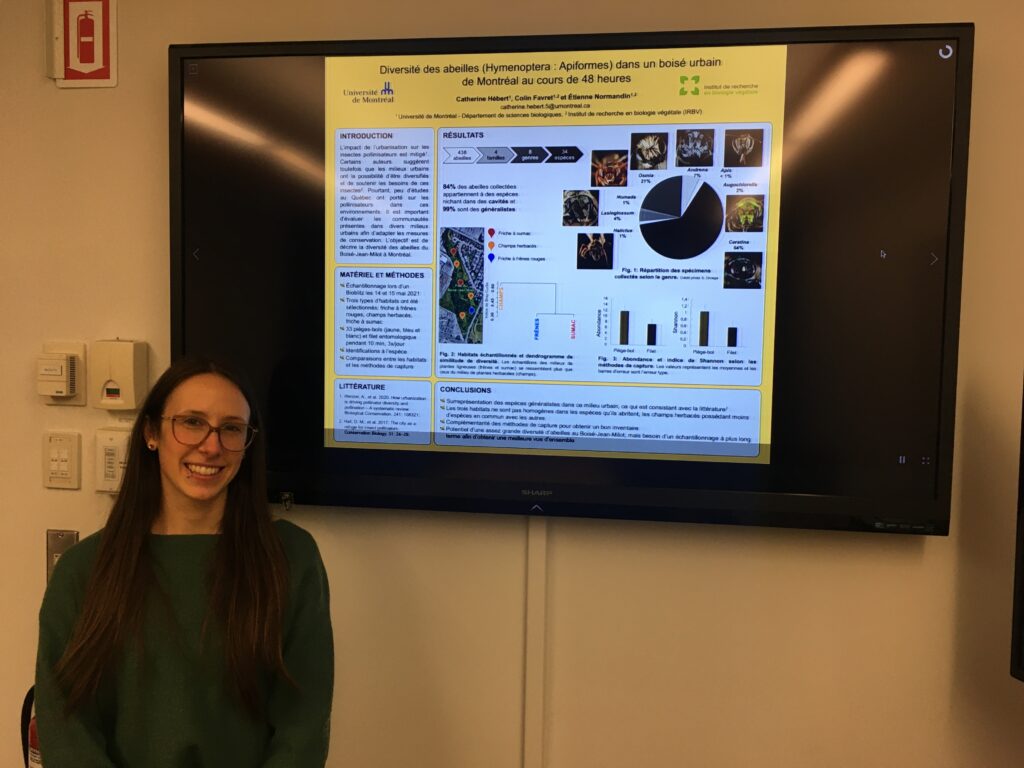
During the virtual banquet following the first day of presentations, Étienne Normandin (collection manager) was awarded the Léon Provancher prize for outstanding contributions to Quebec entomology, not least of which is his magnificent field guide. Many congratulations, Étienne!
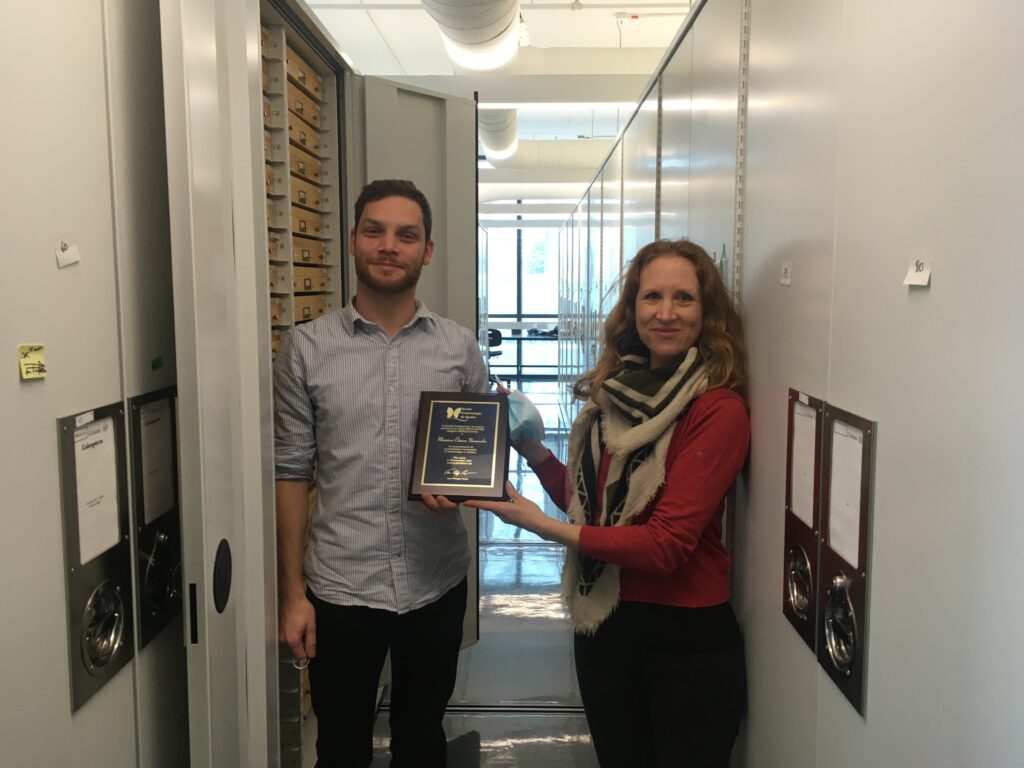
• Adwa receives her master’s
Adwa ABDOU ALI’s thesis has just been formally accepted by the university! Her research, culminating in her thesis titled Insects of the date palm in traditional and modern orchards of Djibouti, compared the abundance of several potential insect pests of date palms in modern, monocultural orchards, and in older, traditional, and polycultural orchards, the kind one might find growing around oases. Both orchard types harbored potential pests, but the modern ones had more pests specialist of date palm, whereas the traditional orchards had a greater abundance of generalist pests.
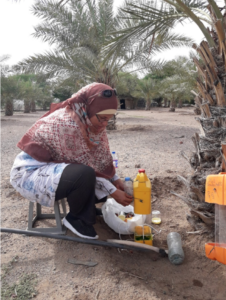
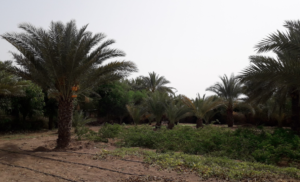
Here’s the abstract:
In recent years, food insecurity and poverty, especially among the rural populations of Djibouti, have been increasing due to population growth and rising world food prices.
As a result, the government of Djibouti seeks to develop sustainable agriculture through date farming. The cultivation of date palms adapts well to the difficult pedoclimatic conditions of the Republic of Djibouti. Massive introductions of date palm have taken place in recent years to restore the older traditional palm groves (polycultures) and to create and/or extend new palm groves oriented towards monoculture.
However, the country faces major phytosanitary challenges: poor infrastructure, insufficient knowledge and a lack of research on the pests of this crop.
With the ultimate aim of protecting and increasing Djibouti’s date yields, this present work seeks to assess the susceptibility of palm groves to insect pests. To achieve this objective, a comparison of the insect fauna of the two types of palm groves was carried out using composite traps placed within the crown of the date palm. The experiment was carried out from 20 June to 2 September 2018, in six orchards on three sites.
The samples documented the existence and diversity of insects in these palm groves, as well as the presence and abundance of specialist date palm pests in monocultural palm groves. Natural enemies were also particularly abundant in the traditional palm groves, but species-level diversity did not show any correlations with type of palm grove.
This study contributes to the knowledge of insect diversity and potential pest species in the palm groves of Djibouti. These pests can have an important impact on date yields depending on the type of palm grove and this study thus underlines the needs to develop adequate means of pest control.
Congratulations Adwa!
• Article: Insects and mycorrhizae in soybean fields
We have published a new article in the journal PLOS ONE. This publication is the first one based on the research of doctoral student Élisée Emmanuel DABRÉ.
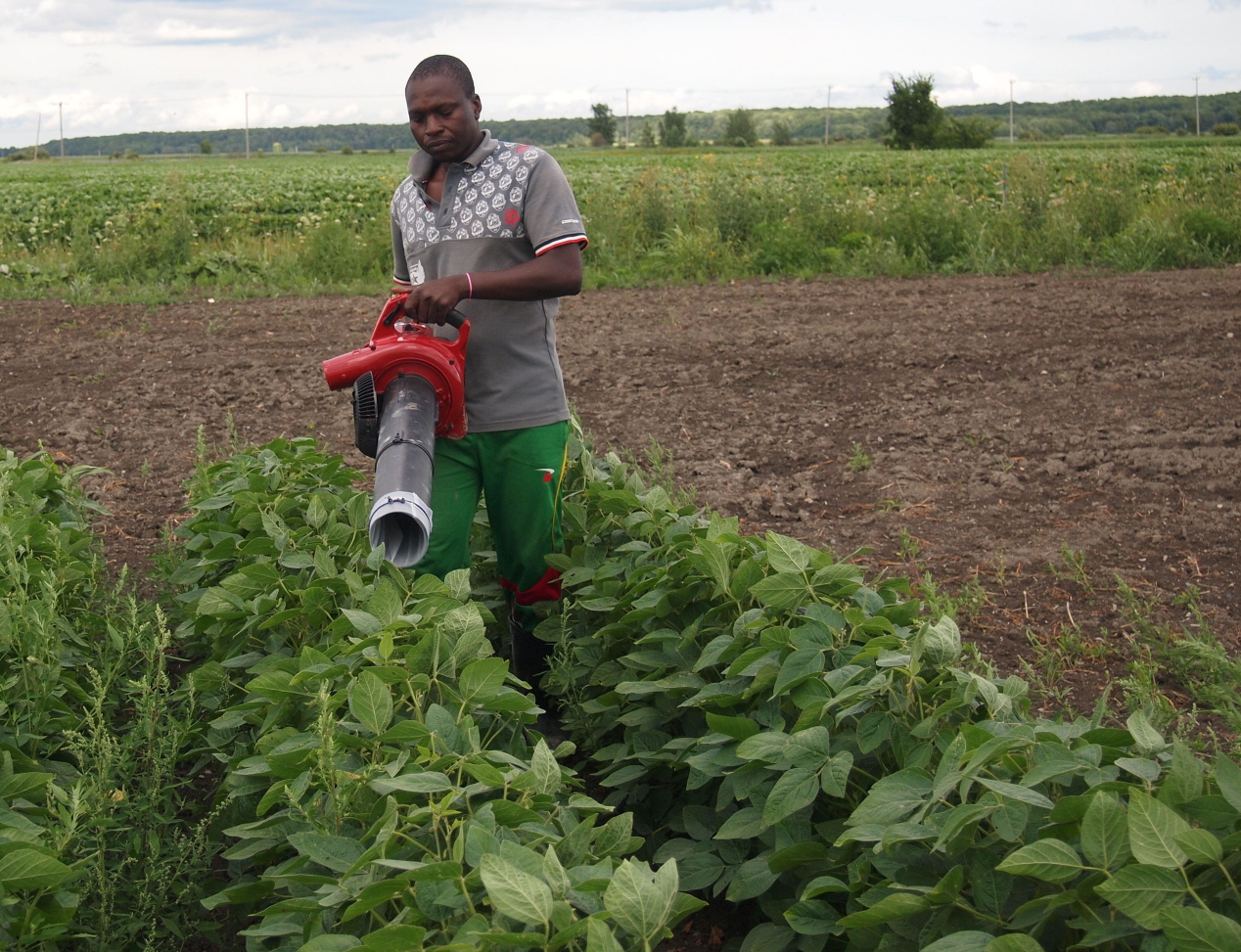
The use of beneficial microorganisms, such as arbuscular mycorrhizal fungi and plant growth promoting rhizobacteria as biofertilizers in agricultural systems, has gained particular interest in recent years due to their positive effects on plant growth and crop yield. While many studies have focused on the indirect effects of these inoculants on insects associated with plants in controlled and semi-controlled environments, very few field investigations have been done.
We carried out an inventory of phytophagous insects and their natural enemies in soybean fields inoculated with spores of the mycorrhizal fungus Rhizophagus irregularis, the rhizobial bacterium Bradyrhizobium japonicum, and a bacteria promoting plant growth, Bacillus pumilus.
We showed in this study that inoculants reduced the abundance of soybean aphid (Aphis glycines) only in the presence of potassium. We also noted a decrease in the number of leafhoppers in the presence of potassium alone, indicating its probable role in the nutrition of these insects. Finally, we detected a negative correlation between the rate of mycorrhizal colonization of the roots and the abundance of piercing-sucking insects. Given that such insects are major vectors of plant disease, it seems that increased mycorrhizal fungal colonization can help protect crop plants.
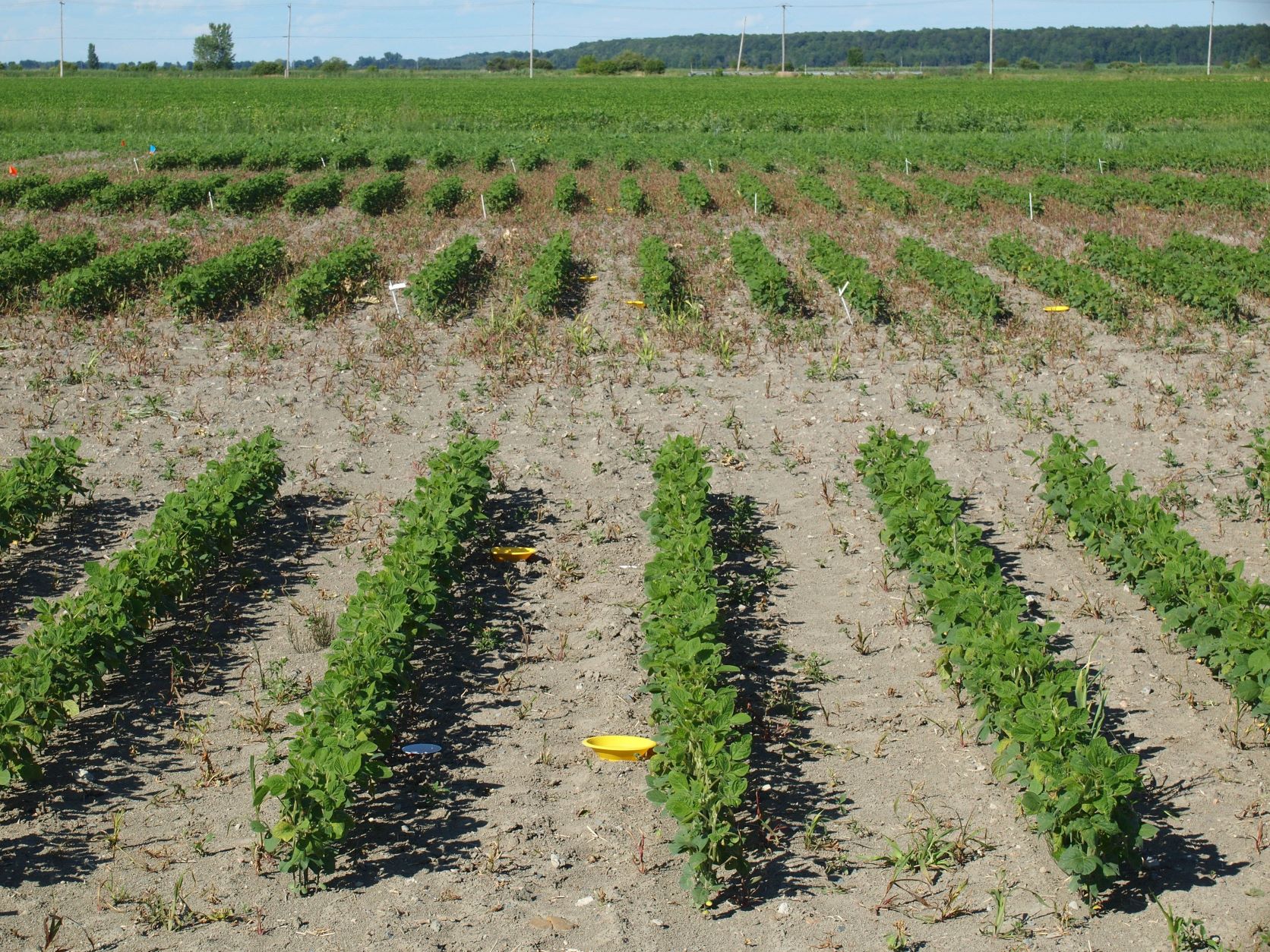
• Article: The Odonata of Quebec
The Ouellet-Robert Collection has a wonderful set of dragonfly and damselfly specimens (insect order Odonata) thanks in large part to the efforts of its eponymous founder, Adrien Robert. Indeed, the Odonata collection is so good that we chose a damselfly, the superb jewelwing (Calopteryx amata), as the emblem for the collection.
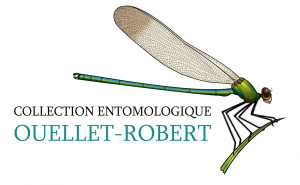
Before I arrived at the University of Montreal, seed funding for Canadensys from the Canada Foundation for Innovation had paid for the digitization of the specimen data associated with the collection’s Odonata. As a first tentative to better integrate the activities of the various insect collections in Quebec, and possibly to federate a more ambitious collaboration, with funding from the Quebec Centre for Biodiversity Science, colleagues and I visited six other Quebec collections and added their Odonata specimen data to the mix. The result is an impressive dataset including 37,000 occurrence records, from 616 different locations, for 137 species. This dataset, whose description is published in the Biodiversity Data Journal, is free to download and use for species distribution modeling, analyzing changes across time, and any number of other research topics. Given that many Odonata species in Quebec are at the northern limits of their geographic range, their possible range expansions northward may be good indicators for measuring the effects of climate change.
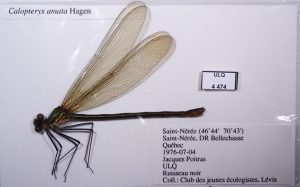
This publication represents the second one in less than a year focusing on the activities in the Ouellet-Robert Collection. The first was an overview of three computerization initiatives, including the Odonata specimen digitization, whereas this second one focuses on the Odonata data themselves.
• Article: Aphid climate niche
The dominant paradigm is that the host plant distributions determine those of plant-feeding insects. However, climate is known to affect the distribution of other organisms, including plants, so who’s to say it doesn’t affect plant-feeding insects too? A group of colleagues sought to answer that very question. We geographically modeled climate variables and host plant and aphid distributions to measure the amount of overlap and how much one may affect the other. For example, perhaps it’s climate conditions that preclude the aphid from being co-located with its host in particular locations. To our North American dataset we added the Cinara aphid collection localities from French and Chinese colleagues, and we used publicly available climate and conifer tree distribution data.
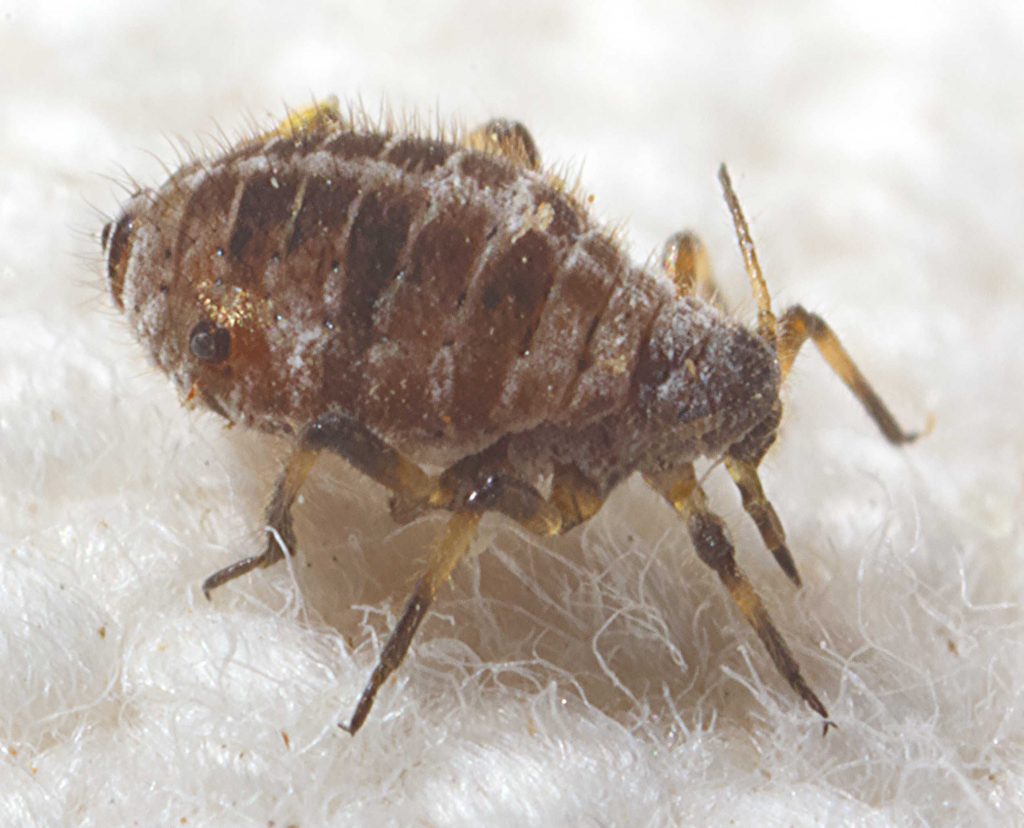
In our paper in Ecology and Evolution, we showed that the distributions of most Cinara species overlap completely with those of their hosts. In those cases, we could not say that climate played a direct constraining role in the aphids’ distributions, but only insofar as it affected that of the host plants. However, almost a third of the Cinara species were present in a reduced portion of their hosts’ range. This result suggests that aphid geographic distribution is constrained by both host and climate factors, and not by host alone.
